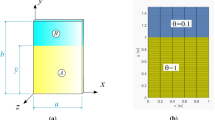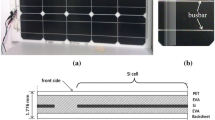Abstract
The aim of the joint project ViPQuali (Virtual Product Qualification) was to describe a component’s ageing behaviour in a given environment, by numerical simulation.
Having chosen polypropylene (PP) as the material, which does not show sensitivity to moisture, the relevant weathering parameters of the dose–response functions could be limited to spectral irradiance and temperature.
In artificial irradiation tests, for PP plates of varied stabiliser content, spectral sensitivity as well as temperature dependence of irradiation-caused crack formation was quantified. For that purpose, samples were exposed both to artificial weathering tests at various constant temperatures and to spectrally resolved irradiation. The temperature dependence could be modelled by an Arrhenius fit. For fitting the spectral sensitivity, a plateau function was chosen. Subsequently, the stabiliser content was parameterised and extrapolated.
The formed dose–response functions were incorporated into a Computational Fluid Dynamics (CFD) software program, simulating the environment of a sample within a Phoenix-exposed IP/DP (Instrument Panel/Door Panel box) box, based on sun position and weather conditions, including radiation interactions. Observed local effects as well as the general ageing advance of PP hats are compared with respect to simulation and experiment.
Resulting from this project, for this most simple example of PP of varied stabiliser content, the time to failure can be estimated for each weathering exposure environment with known time-resolved irradiance and temperature conditions.
Access this chapter
Tax calculation will be finalised at checkout
Purchases are for personal use only
Similar content being viewed by others
Notes
- 1.
BMBF, fund no. 01RI05203, 2006–2011
- 2.
If necessary, also nonlinearities in the damage increase have to be considered (e.g. saturation in colour change).
- 3.
Furthermore, for bulk properties, oxygen diffusion can be a limiting factor on timescale. Diffusion can be neglected for surface-related properties only.
- 4.
Possible dependence of spectral sensitivity on temperature [5] is neglected here.
- 5.
A very low carbon black amount was added to achieve higher solar heating, but not for stabilisation increase, primarily.
- 6.
Measured by FTIR/ATR
- 7.
Hats were higher stabilised, as otherwise too early failure was expected, in IP/DP box weathering.
- 8.
For PP, he investigated duration until a specific carbonyl absorbance was found. For PE, 50 % residual tensile strength was examined.
- 9.
At 5 °C, no failures occurred after 380 MJ/m2 UV radiant exposure.
- 10.
Maximum surface temperature for uncoloured PP is about 10 K lower.
- 11.
This could be clarified by further experiments only (e.g. IP/DP box exposure of lower stabilised PP hats). However, ViPQuali project finalised.
References
Wypych G (2008) Handbook of material weathering, 4th edn. ChemTec Publishing, Toronto, Canada, p 211ff. ISBN 978-1-895198-38-6
Reichert T, Müller A, Lichtblau A, Schönlein A, Geburtig A, Fluche B, Brocke H, Köhl M, Manier G (2009) Virtual product qualification for sustainability ViPQuali. Proceedings 4th European weathering symposium—natural and artificial ageing of polymers, Sept 2009, Budapest, Hungary, pp 377–386, ISBN 978-3-9810472-8-8
Kockott D (1989) Natural and artificial weathering of polymers. Polym Degrad Stab 25:181–208
Czichos H, Saito T, Smith LE (eds) (2011) Springer handbook of materials measurement methods. Springer Handbooks, ISBN 978-3-642-16640-2
Trubiroha P, Geburtig A, Wachtendorf V (2004) Determination of the spectral response of polymers, Proceedings of the 3rd international symposium of service life prediction, Sedona, pp 241–253, ISBN 0-934010-60-9
Geburtig A, Wachtendorf V (2010) Determination of the spectral sensitivity and temperature dependence of polypropylene crack formation caused by UV-irradiation. Polym Degrad Stab 95:2118–2123
Gugumus F (1993) Current trends in mode of action of Hindered Amine Light Stabilizers. Polym Degrad Stab 40:167–215
Müller A, Vatahska T, Geburtig A, Manier G, Reichert T, et al. (2012) Numerische Simulation von Materialalterung: Das VipQuali-Simulationstool, Handbuch der 41. Jahrestagung der GUS, Stutensee, Germany, March 2012, pp 57–68, ISBN 978-3-9813136-4-2
Geuskens G, Kabamba MS (1982) Photo-oxidation of polymers—part V: a new chain scission mechanism in polyolefins. Polym Degrad Stab 4:69–76
Arnaud R, Lemaire J, Jevanoff A (1986) Photo-oxidation of ethylene-propylene copolymers in the solid state. Polym Degrad Stab 15:205–218
Trubiroha P (1989) The spectral sensitivity of polymers in the spectral range of solar radiation. In: Patsis AV (ed) Advances in the stabilization and controlled degradation of polymers, vol I. Technomic Publishing, Lancaster, pp 236–241
Author information
Authors and Affiliations
Corresponding author
Editor information
Editors and Affiliations
Rights and permissions
Copyright information
© 2015 Springer International Publishing Switzerland
About this paper
Cite this paper
Geburtig, A. et al. (2015). Polypropylene Numerical Photoageing Simulation by Dose–Response Functions with Respect to Irradiation and Temperature: ViPQuali Project. In: White, C., Martin, J., Chapin, J. (eds) Service Life Prediction of Exterior Plastics. Springer, Cham. https://doi.org/10.1007/978-3-319-06034-7_14
Download citation
DOI: https://doi.org/10.1007/978-3-319-06034-7_14
Published:
Publisher Name: Springer, Cham
Print ISBN: 978-3-319-06033-0
Online ISBN: 978-3-319-06034-7
eBook Packages: EngineeringEngineering (R0)




